“Each year Solomon received about 25 tons of gold.”
1 Kings 10:14 (NLT)
(That is about US$1.3 billion @ US$58 million/mt. He also received four metric tons of gold from the Queen of Sheba as a gift.)
“Gold — what can it not do, and undo?”
William Shakespeare (Cymbeline, Act II, Scene III, circa 1611)
Discover the purpose of your work and your corporation
What is your purpose in work?
- Transform Borneo’s gold mining industry by setting new standards and implementing modern technology.
- Halt the pollution of rivers by wildcat miners who use mercury.
- Provide new employment opportunities.
- Elevate the social and economic well-being of the local community.
What drives your corporation’s core value?
- Capitalise on emerging market opportunities to expand our investment portfolio.
- Improve critical infrastructure like roads, water supply, and electricity and develop social amenities such as schools and healthcare centres in remote communities through the mining projects.
“Welcome Stranger”. In 1869, Australian prospectors John Deason and Richard Oate discovered the largest gold nugget. It weighed 97.14 kilograms (3,524 ounces).
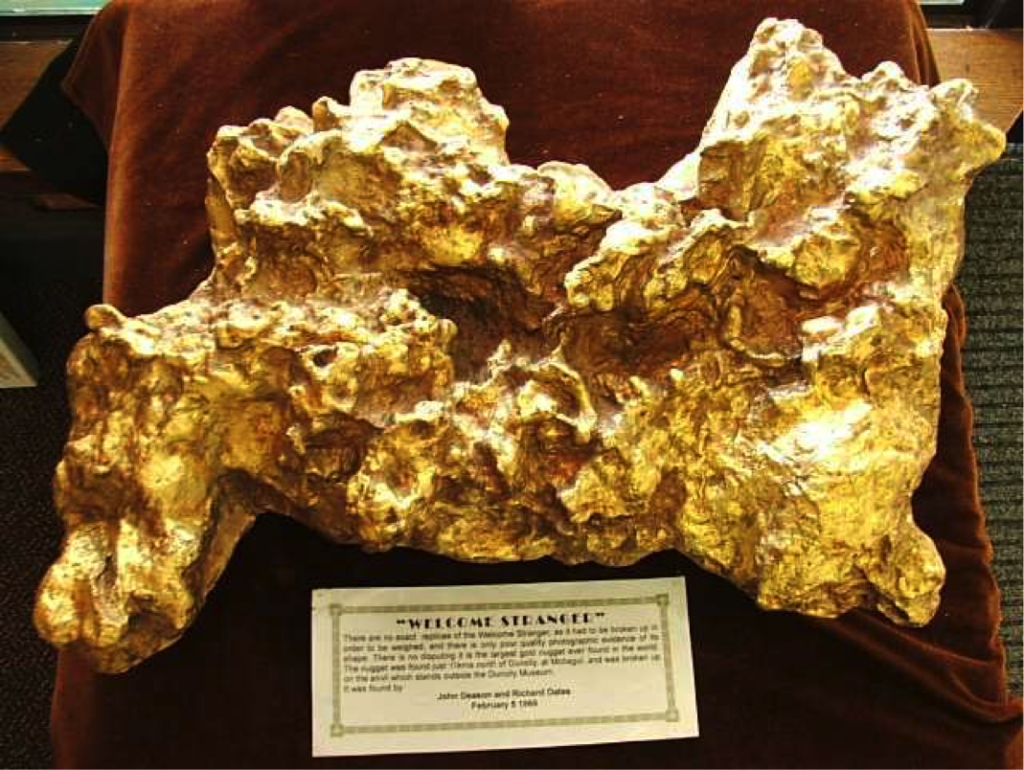
1.0 Executive Summary
Mission
- Entity: Form a strategic investment team comprising international foreign investors, government agencies, and target market buyers to invest in various facets of gold mining, including exploration, site planning, infrastructure development, production, and reclamation.
- Stage 1: Commence gold mine exploration and production targeting 42.53 million metric tons or 1,500,000 ounces of gold.
Key Management Team
- Mentors: Visionary pioneers and industry leaders with a vast global network, offering invaluable guidance and inspiration.
- Coaches: Mission-oriented industry experts providing practical solutions to challenges, ensuring the team remains focused on its objectives.
- Partners:
- A project leadership group experienced in successful development, operation, and financial management within the gold mining industry.
- A reputable investment manager with access to funding sources within the gold mining sector.
- Government agencies providing financial incentives and robust business support.
- A credible local gold mining developer with procurement capabilities, local connections, solid financial stability, and strong government backing.
- Target market end-users, including gold traders and importers.
Product Benefits
- Uses: Gold has diverse applications, including jewellry, industrial, and investment purposes.
- Benefits: Gold mining will bring economic and social advantages to local communities.
- Timing: Gold mining aligns with global gold demand and prices, ensuring measurable margins.
- Liquidity: A consistent international demand exists for the gold product.
Target Market
- Customers: Large gold importers and smelters primarily from China and India.
Financial Projections
- Investment: Initial capital requirement of US$170 million.
- Cost: Total cost estimated at US$1.18 billion (calculated as US$783 per ounce multiplied by 1.5 million ounces).
- Revenue: Anticipated revenue of US$1,875 billion (calculated as US$1,250 per ounce multiplied by 1.5 million ounces).
- Income: Expected income of US$0.695 billion (revenue minus cost).
- Payback: A 3-year payback period, commencing from the production year.

Unique Business Model
- Team: Comprises a top international gold mining team with proven track records.
- Partners: Leverages the unique strengths of various partners within a single entity, all driven by common goals.
- Finance: Backed by solid financial support.
- Demand: Benefits from a strategic partnership with target customers from India and China.
- Location: Enjoys easy access to the target markets.
2.0 Mission
2.1 Problem
- Issues: Borneo faces environmental harm due to unsustainable gold mining practices, including illegal methods and pollution.
- Explore: Lack of systematic gold reserve assessments and past fraudulent exploration undermine the local mining industry.
- Quality: The sector lacks quality control due to small-scale speculators’ dominance.
- License: Complex mining laws hinder foreign investment.
2.2 Solution
- Partner: Forge alliances with reputable local and foreign gold mining groups to establish international mining standards with better waste management.
- Incentive: Attract foreign investors and specialists through resource allocation, fiscal incentives, and favourable government policies.
2.3 Mission
- Entity: Create a strategic investment team involving international investors, government agencies, and target market buyers for gold mining, from exploration to reclamation.
- Stage 1: Launch gold mine exploration and production targeting 42.53 million metric tons or 1,500,000 ounces of gold.
3.0 Product
3.1 Product Description
Gold is a precious metal that carries profound emotional and cultural significance. It’s often described in the following ways:
- “We have gold because we cannot trust governments.” – Herbert Hoover
- “Gold is money. Everything else is credit.” – J. P. Morgan
- “Gold in my hand is more dependable than a filial son.” – Chinese proverb
- Merriam-Webster defines gold fever as the “contagious excitement of a gold rush,” characterized by symptoms such as a peculiar sensation around the heart, occasional headaches, daytime restlessness, and an inability to carry out daily tasks. This definition harks back to the New Zealand Evangelist’s 1849 article.
- Gold fever, akin to the frenzied rushes seen in California and New South Wales, is exemplified by events at jade mines in Myanmar, reflecting the same exhilarating gold rush phenomenon.
Gold serves various essential purposes, including:
- Jewellery: Gold is a prized material for crafting exquisite jewellery due to its lustre, durability, and timeless appeal.
- Investment: Investors often turn to gold as a reliable store of value, particularly during economic uncertainties or inflationary periods.
- Technology Industry: Gold is a crucial component in various electronic and technological applications due to its excellent conductivity and corrosion resistance.
- Dentistry: Dentists utilize gold alloys in dental restorations and prosthetics because of their biocompatibility and durability.
- Financial Security: Many individuals and institutions use gold as a hedge against financial instability and currency devaluation.
Gold mining involves the extraction of this precious metal from the Earth, typically through either surface or underground operations.
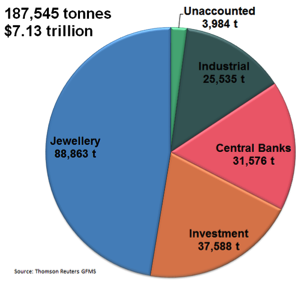
Source: Gold Industry Group. Suchecki, 2016

Source: US Money Reserve. Diehl, 2014
3.2 Product Attributes
Gold mining is:
- Resource-Intensive: Demanding substantial financial investments, time, and specialized expertise.
- Long-Term: Involving a lengthy cycle from exploration to production.
- Risk-Prone: Carrying financial and environmental risks.
- Specialised: Requiring collaboration with expert groups.
- Environmentally Aware: Involving environmental considerations and responsible practices.
Mining Life Cycle:

3.3 Product Benefits
Gold mining offers a range of compelling benefits:
- Versatility: Gold finds application in diverse sectors, from jewelry to industrial uses, making it a valuable commodity.
- Community Impact: Gold mining contributes to the economic and social well-being of local communities by generating employment and economic opportunities.
- Market Alignment: Gold mining operations can align with global gold supply and demand trends, ensuring a measurable profit margin.
- High Liquidity: The gold product consistently attracts international buyers, ensuring a readily accessible market.
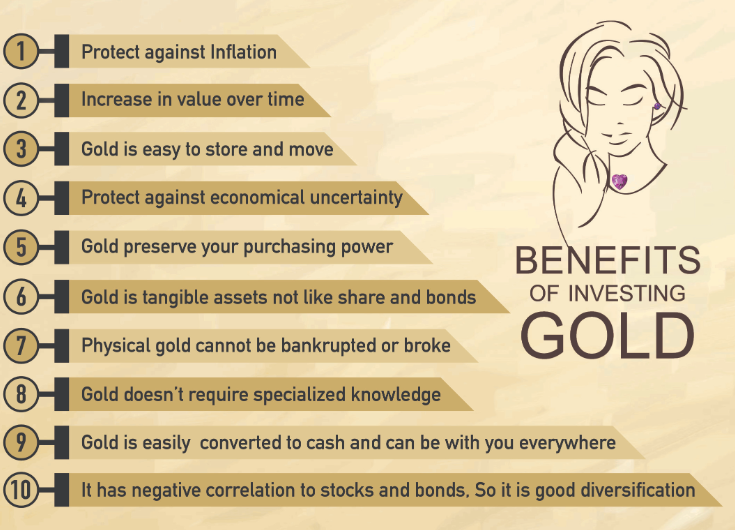
3.4 Product Competitive Advantages
- Expert Team: The stakeholders consist of industry-leading specialists in gold mining, providing unparalleled expertise.
- Cutting-Edge Technology: Partnering with international mining groups allows leverage of the state-of-the-art mining technology, improving productivity and safety for our operations.
- Licencing Assurance: Obtaining licenses and permits for international mining operators assures a full mining life cycle, enhancing operational stability.
- Market Engagement: Collaborating with nations that are the end buyers of gold ensures support from the target market.
4.0 Market
4.1 Market Segment
World gold demand by segment

4.2 Target Market Segment Strategy
- Partnerships: Form alliances with end buyers, international and local mining groups, and government agencies.
- Risk Sharing: Collaborate with stakeholders to share risks across exploration, production, and financial returns.
- Stability: Aim for stable, long-term financial returns, ensuring consistency in our approach.
- Financial Incentive: Strong financial returns incentivize investors to expand exploration and production, benefiting all parties.
Gold market segment stakeholders

The gold supply chain
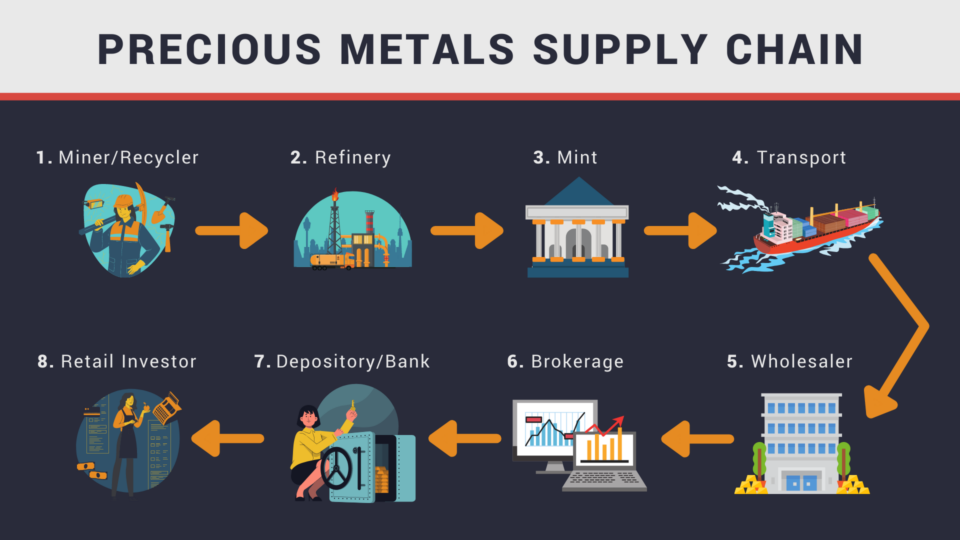
4.3 Market needs
4.3.1 World jewellery consumption
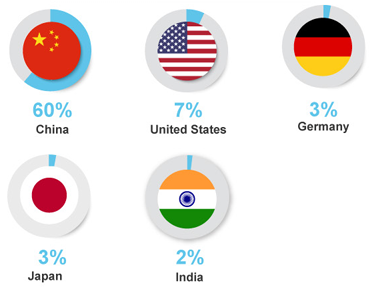
4.3.2 Global Gold Trade 2021
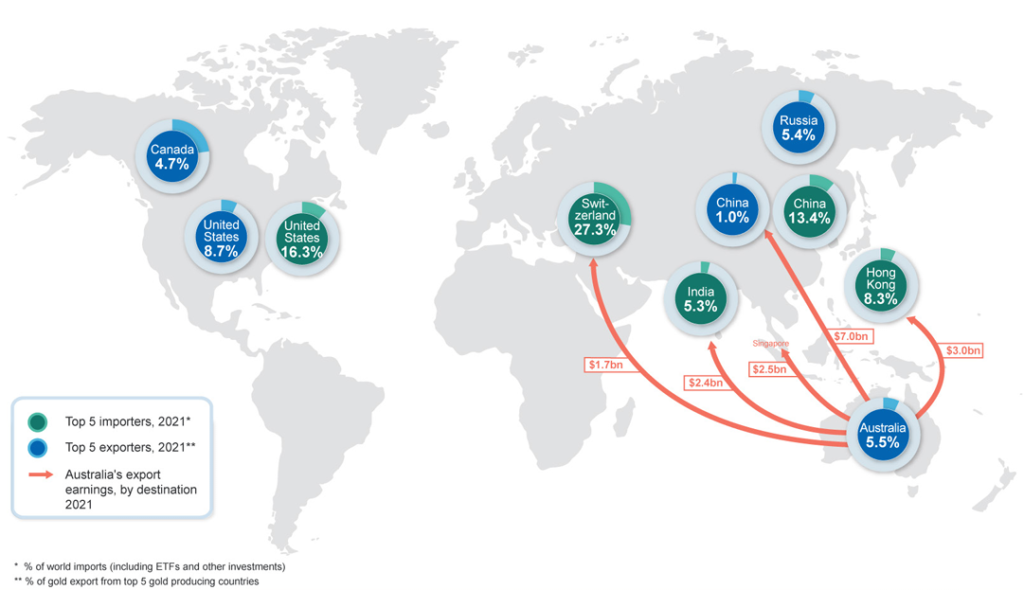
4.3.3 Gold Demand Outlook

Regional Demands (China)
In 2019, China’s gold demand was as follows:
- Jewellry: 676.23 tonnes
- Bar & Coin: 225.80 tonnes
- Industrial: 100.75 tonnes
- Total Consumption: 1,002.78 tonnes
As of February 2022, China’s gold reserve stood at:
- Gold Reserve: 1,948.30 tonnes
Additionally, China imported:
- Gold Imports: 987.70 tonnes
Source: China Gold Association 2020 / Gold.org Wang 2022 / Wikipedia 2022
Regional Demands (India)
In 2019, India’s gold demand was as follows:
- Jewellry: 544.6 tonnes
- Bar & Coin: 145.8 tonnes
- Total Consumer Demand: 690.4 tonnes
As of February 2022, India’s gold reserves stood at:
- Gold Reserves: 754.1 tonnes
Additionally, India imported:
- Gold Imports: 831.0 tonnes
Recycled gold contributed:
- Recycled Gold: 119.5 tonnes
Source: The Hindu. PTI 2022 / Reuters. Ahmed and Jadhav (2020) / Wikipedia 2022
4.4 Growth Drivers
Key drivers of growth include:
- Economic Expansion: Robust economic growth in India, China, and Turkey drives demand for gold among the growing middle class.
- Price Surge: Gold’s value has risen due to its appeal as a safe-haven investment amid the uncertainty of the Covid-19 pandemic.
- Enhanced Efficiency: Leveraging data technology boosts competitiveness, productivity, and cost efficiency, bolstering EBITDA.
- Geopolitical Concerns: Increasing global tensions fuel gold demand as consumers seek stability in uncertain times, especially in response to trade wars and macroeconomic shifts.
4.5 Key Customers
China
1. China gold ETF holding groups
- BOC Shanghai Gold ETF
- Bosera Gold ETF
- CCB Shanghai ETF
- China AMC Gold ETF
- Dacheng Shanghai Gold ETF
- Efund Gold ETF
- First Seafront Gold ETF
- Fullgoal (Wells Fargo) Shanghai Gold ETF
- GF Shanghai Gold ETF
- Guotai Gold ETF
- Harvest Shanghai Gold ETF
- Huan Yifu Gold ETF
- ICBC Credit Suisse Gold Fund
- Ping An Shanghai Gold ETF
- Southern Shanghai Gold ETF
- Tianhong Shanghai Gold
Source: Shanghai Gold Exchange: Gold ETF
2. People’s Bank of China (PBoC) approved lists of banks with gold import licences.
Foreign Banks:
- HSBC Bank (China) Ltd
- Australian and New Zealand Bank (China) Company Ltd
- Standard Chartered Bank (China) Ltd
- United Overseas Bank (UOB)
Local Banks:
- Industrial and Commercial Bank of China (ICBC)
- China Construction Bank (CCB)
- Bank of China
- Agricultural Bank of China
- Bank of Shanghai
- China Minsheng Bank (CMB)
- Industrial Bank
- Shenzhen Development Bank (SDB) / Ping An Bank
- Everbright
- Bank of Communications (BoCom)
- Shanghai Pudong Development Bank
- China Merchants.
Source: Bullionstar c. 2016
3. Shanghai Gold Exchange members
Members: 291 as at 02 September 2022
Source of list: Shanghai Gold Exchange: Gold ETF
India
1. Entities that can import gold bar
Directorate General Of Foreign Trade (DGFT) permitted entities to import gold bars to India:
- Metals and Minerals Trading Corporation Limited (MMTC)
- Handicraft and Handloom Export Corporation (HHEC)
- State Trading Corporation (STC)
- Project and Equipment Corporation of India Limited. (PEC)
- STCL Limited
- MSTC Limited
- Diamond India Limited (DIL)
- Gems & Jewellery Export Promotion Council (G&J EPC)
- Star Trading House (only for Gems & Jewellery sector) or a Premier Trading House
- Any other agency authorized by Reserve Bank of India (RBI)
Source: Indian Fillings
2. Banks authorised to import gold for FY 2022-23
- Axis Bank Limited
- Bank of Baroda
- Bank of India
- Federal Bank Limited
- HDFC Bank Limited
- Industrial and Commercial Bank of China Limited
- ICICI Bank Limited
- IndusInd Bank Limited
- Indian Overseas Bank
- Kotak Mahindra Bank Limited
- Karur Vysya Bank Limited
- Punjab National Bank
- RBL Bank Limited
- State Bank of India
- Union Bank of India
- Yes Bank Limited
Source: India’s Central Bank. 2022
3. List of refineries/mint granted licence 2022
Source: BIS.
4.6 Competition and industry
1. World Gold Supply
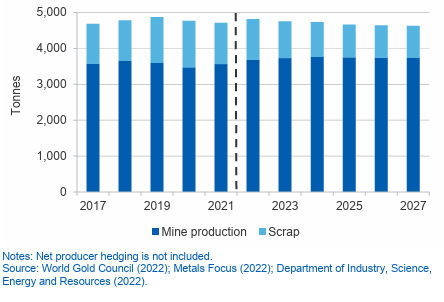
2. The World’s Top 10 Gold Mining Companies.
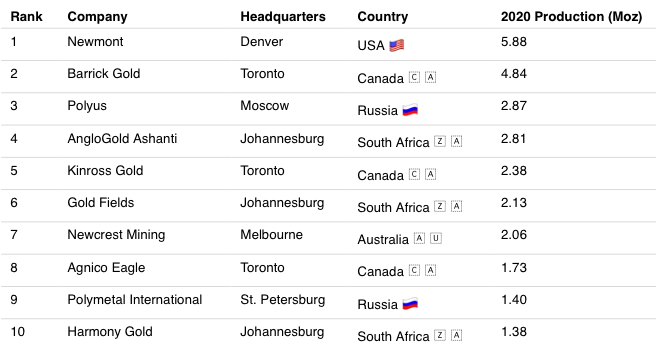
https://elements.visualcapitalist.com/the-worlds-top-10-gold-mining-companies/
3. Largest gold mines by 2022 production
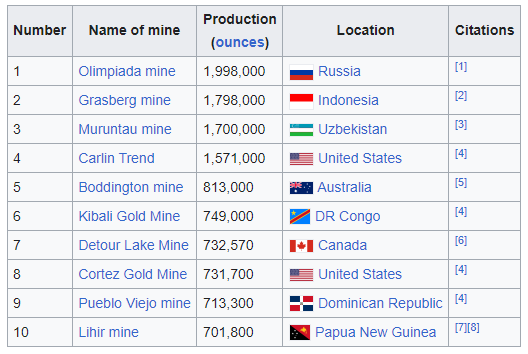
4. Top 5 gold producing countries
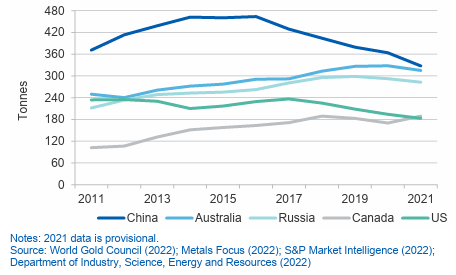
5. Key Local Gold Mines
Indonesia
- Grasberg Mine
- Ownership: Freeport McMoran (48.77%), Government of Indonesia (51.23%)
- Gold Deposit: 67.4 million ounces
- 2016 Production: Copper (482,000 mt), Gold (33 mt), Silver (90 mt)
- Batu Hijau Mine
- Ownership: PT Amman Mineral Internasional (82.2%)
- Reserves: 914 mt of ores grading at 0.53% Cu and 0.40 g/t Au.
- 2020 Production: Copper (293.9 million pounds), Gold (132,100 ounces), Silver (813,400 ounces)
- Martabe Mine
- Ownership: Investment consortium (95%)
- Reserves (2013): Gold (3 million oz), Silver (31.9 million oz)
- Gosowong Operation (Kencana and Toguraci Mines)
- Ownership: PT Antam (Persero) Tbk (25%)
- 2019 Production: 190,000 ounces of gold at AISC of $1,099/oz
- 2021 Reserve: 860,000 oz of gold
- Baru Gold Corp Projects
- Projects in Sangihe North Sulawesi and Miwah Aceh Province.
- Resource: Over 3.3 million ounces of gold
- Indonesia Gold Provinces
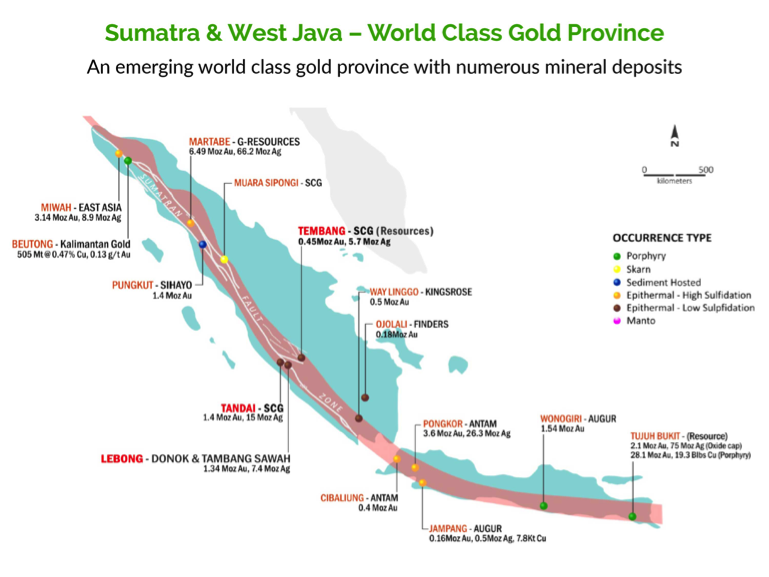
Sarawak Gold Mine
1. Bau Gold Mine: 3.3 million ounces resource
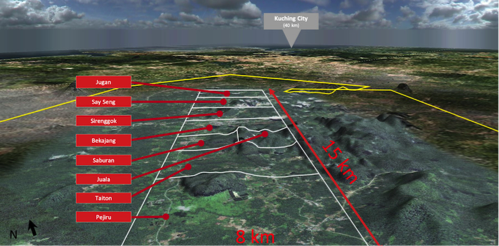
Sabah Gold Mines
- Bukit Mantri Gold Mine in Tawau

2. Mamut Mine
- Production: 2.1 million tonnes of concentrates containing 520,000 copper, 39 tonnes of gold, and 255 tonnes of silver. The mine operated from 1975 to 1999.
3. North Borneo mineral map 4. Porphyry copper deposits in Borneo Island
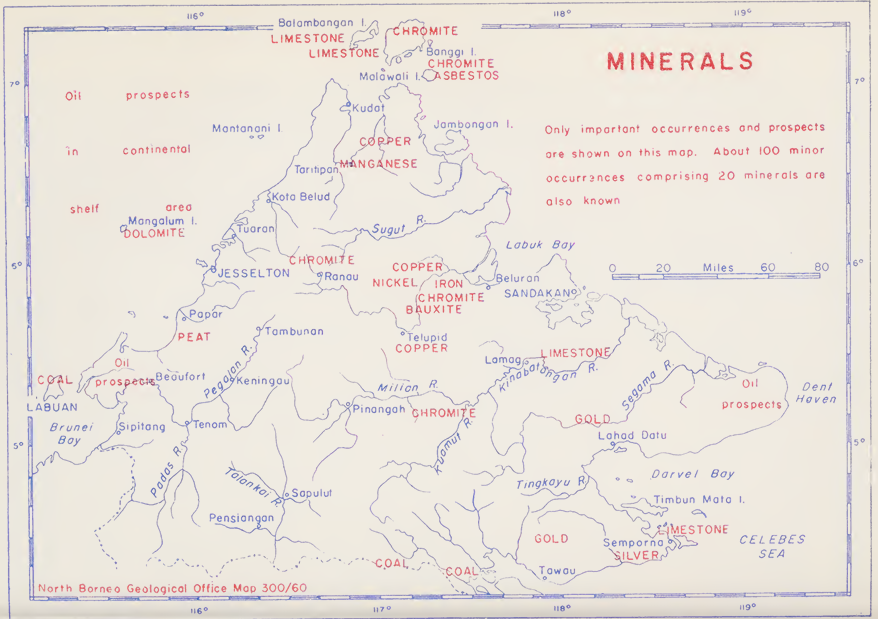
Source: Sea-Delt / North Borneo Annual Report 1960
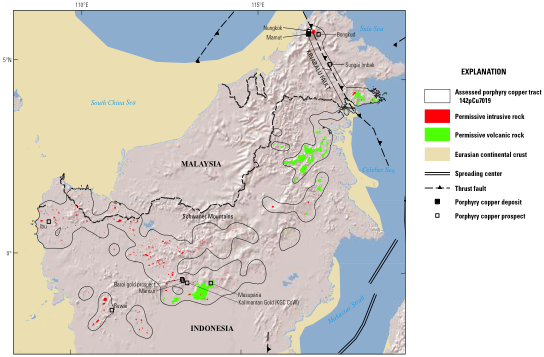
Source: USGS. Zientek, Hammarstrom, Johnson 2010
5.0 Operation
5.1 Gold mining process flow: 5.2 Gold Extraction Process:
Example: Yanfolila Gold Project, Mali Example Donlin Gold
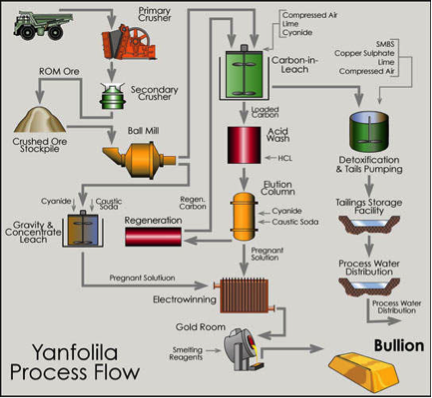
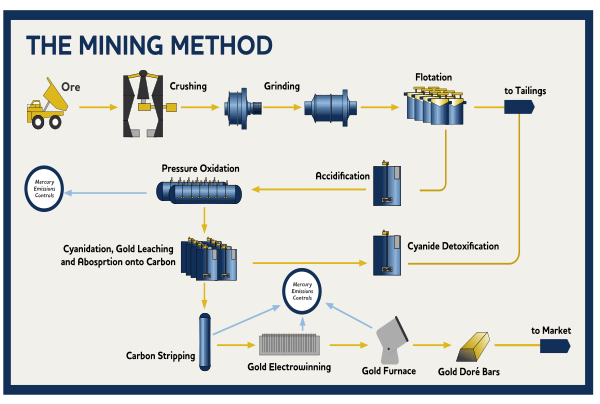
5.3 Mining project phase
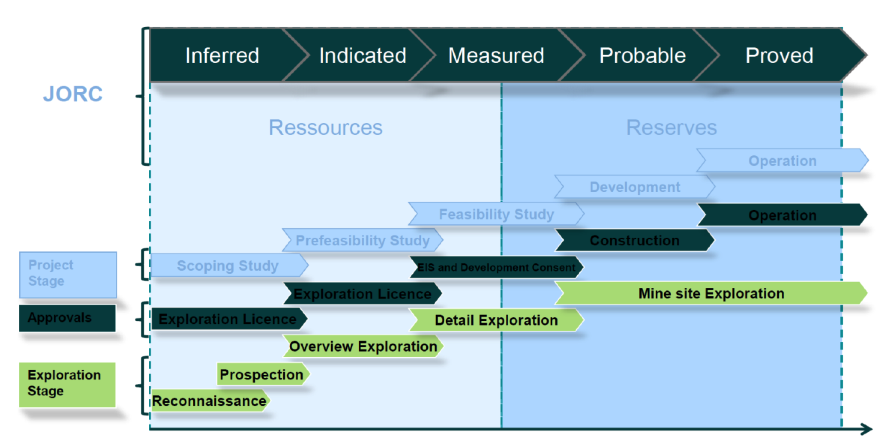
5.4 Mining operation key partners
- Environmental impact statements and data analysis that supports mining operations.
- High-performance drilling specialists
- Crushing gear suppliers and subcontractors
- Professional geological services providers on resource estimation
- Logistic and transport group to support and manage the critical supply chain
- Blasting services professional that maintains an efficient and safe operation
- Inspection and superintending services
- Lab for assaying, sample preparation and analysis
- Mining operation and process designer
6.0 Financial Implications
6.1 Investment Segment
- Location: The gold mine investment will primarily target the Kalimantan and Sarawak regions in Borneo.
- Investment: The capital expenditure (Capex) for a new mine can vary significantly depending on geographical, technical, and financial factors. Here are some Capex examples:
- High (H) International Capex Range: US$508 million–US$1.3 billion
- Medium (M) International Capex Range: US$210 million–US$405 million
- Low (L) International Capex Range: US$51 million–US$185 million
- Capex Range in Indonesia: US$130 million–US$163 million
Proposed Capital Investment for Target Gold Mine:
- Target Gold Mine: 42.53 million metric tons/1,500,000 ounces
- Mine Life: 10 years
- Start-Up Capital: US$170 million
Case Study 1: PT Merdeka Copper Gold – Tujuh Bukit Gold Mine, Indonesia
- Mineral Resource (2016): Gold 2.2 million ounces, Silver 74 million ounces
- Mine Life: 9 years
- Capital Expenditure (Capex): US$130 million to US$163 million (Life of Mine)
- Operating Cost: US$488 per ounce or US$11.46 per ton of ore
- Internal Rate of Return (IRR): 55%
- Payback Period: 1.9 years from the start of production (assuming US$1,250/ounce for gold and US$15/ounce for silver)
Case Study 2: PT Masmindo – Awak Mas Gold Project, South Sulawesi, Indonesia
- Resource (2021): 51.3 million metric tons at 1.39 g/t Au for 2.28 million ounces
- Ore Reserve (2020): 35.6 million metric tons at 1.33 g/t Au for 1.53 million ounces
- Mine Life: 16 years
- Target Gold Production: 127,000 ounces per year (2020 update)
- Capex: US$146 million
- IRR: 20% (Based on US$1,250/ounce)
- All-In Sustaining Cost (AISC): US$758 per ounce
- Plant: Processing capacity to increase from 2.5 million metric tons per annum to 3.9 million metric tons per annum
Case Study 3: Sihayo Gold Project, North Sumatra, Indonesia (2020)
- Resource: 24 million metric tons at 2.0 g/t Au for 1.5 million ounces insitu gold metal
- Ore Reserve: 12 million metric tons at 2.1 g/t Au for 840,000 ounces
- Mine Life: 8 years
- Target Gold Production: 2.0 million metric tons per annum
- Capex: US$144 million
- IRR: 28% (Based on US$1,700/ounce)
- AISC: US$709 per ounce
- Payback Period: 33 months
6.2 Production Cost
• Target AISC (All-In Sustaining Cost): US$783/ounce • Total Cost: US$783/ounce X 1.5 million ounces = US$1.18 billion
Production Cost Examples in Indonesia:
- Case Study 1 (2020 Sihayo Gold Project): AISC = US$709/ounce.
- Case Study 2 (2021 Tujuh Bukit Project): AISC/Cash Costs = US$1,342/ounce (outlook for 2021 AISC = $825 to $900/oz).
- Case Study 3 (Awak Mas Gold Project): AISC = US$750/ounce.
Production Cost Examples International:
- Case Study 1 (2019): AISC for Australia and New Zealand = US$878/ounce.
- Case Study 2 (2020): AISC analysis of 17 large global companies = US$662 – US$1,500/ounce. Q1 2020 median AISC = US$975/ounce.
- Case Study 3 (2021 Bellevue Gold Project): AISC = US$783/ounce.
- Case Study 4 (2020): Lowest cost among the top 20 largest gold producers by production.
Lowest cost
AISC of the 17gold producers
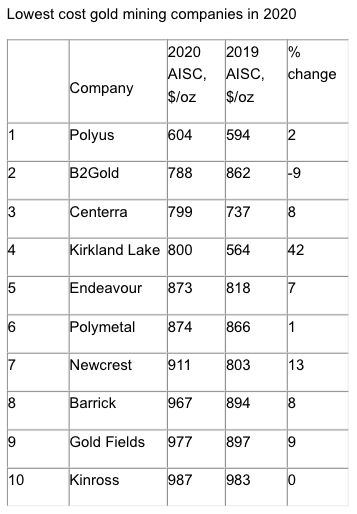

Source: Kitco News. Basov 2021
Source: S & P Global Market Intelligence. Krizka Danielle Del Rosario 2020
- Case study 5: Gold mine total cash and sustaining costs, selected countries
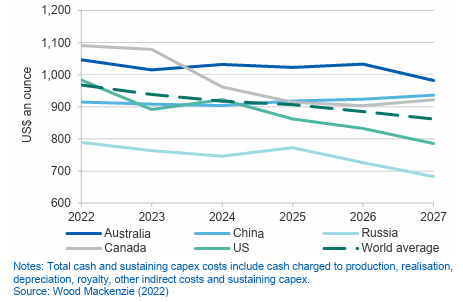
6.3 Price and Revenue
• Target Gold Price: US$1,250/ounce • Target Total Revenue: US$1,250/ounce X 1.5 million ounces = US$1.875 billion
Case Study Price Range from July 2019 – July 2020:
- Gold prices fluctuated between US$1,400/ounce and US$1,900/ounce.
Gold Price and Real US 10-Year Treasury Yield:
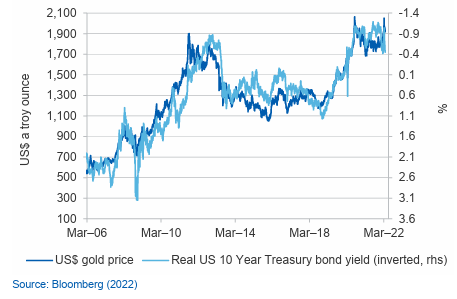
6.4 Financial Returns

Case Study Summary
- IRR Return on Projects: IRR varies from 15% to 55% and depends on factors such as the prevailing gold price and All-In Sustaining Costs (AISC).
- Payback Period: Typically falls in the range of 1 to 3 years, starting from the date of production.
- Gold Prices: Over the past 10 years, gold prices have consistently remained above US$1,000 per ounce, indicating a favourable market for gold-related projects.
International Group: 2019 financial incomes
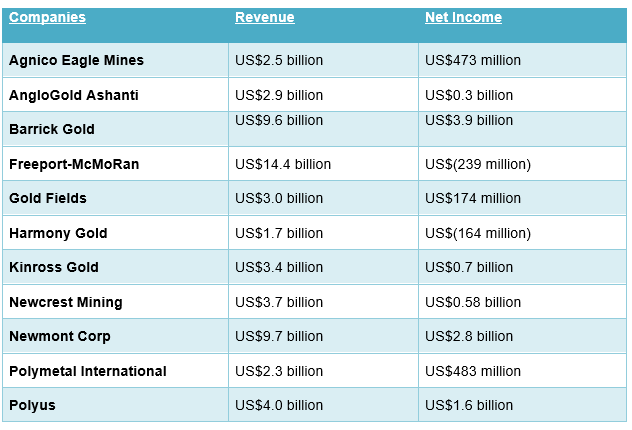
Local Group: 2019 financial incomes
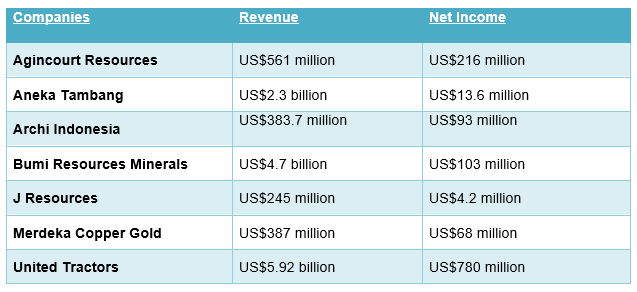
6.5 Source of Funding
1. Strategic Investors:
- New Investor: A project leader with expertise in business and financial management.
- Financier: Gold mining private equity and investor groups.
- Gold Mining Operator: Both international and local gold mine developers and operators.
- Target Market: Gold traders and major gold importers from China and India. These partnerships can provide crucial financial support.
2. Private Equities and Investors
- 1832 Asset Management
- 1st Financial
- Acorn Capital
- Alto Adige Banca
- Altrinsic Global Advisors
- Apollo Global Management
- AQR Capital Management
- Artisan Partners
- Astra International
- AXA Mandiri Financial Service
- Baker Steel Capital Managers
- Baillie Gifford
- Bain & Co
- BC Investment Management
- BlackRock
- Blackstone Group
- Brookfield Capital Partners
- Candriam Belgium
- Capital International Group
- Capital Research & Management
- China National Gold Group Corporation
- Condire Management
- C.M. Bidwell & Associates
- Contour Asset Management
- Coronation Asset Management
- Denham Capital Management
- Dimensional Fund Advisors
- Dodge & Cox
- DWS Investment
- Emirates Investments Group
- EMR Capital
- ETF Managers Group
- Fairtree Asset Management
- Farallon Capital
- Fidelity Investments
- finnCap Group
- First Eagle Investment Management
- First Horizon Advisors
- First Trust Advisors
- Flossbach von Storch
- Generali Investments
- Geode Capital Management
- GQG Partners
- Greenstone Resources
- Greystone Managed Investments
- Hartmann International
- Hotchkis & Wiley
- HSBC Global Asset Management
- Ibaera Capital
- Incomet Capital
- Independent Franchise Partners
- Invesco Advisers
- Investment Construction Technology ICT Group
- Johnson Investment Counsel
- JP Morgan Asset Management
- KKR
- Kopernik Global Investors
- LGT Capital Partners
- Lion Global Investors
- M&G Investment Management
- Mackenzie Investments
- Macquarie Investment Management Business Trust
- Manulife Asset Management Indonesia
- Massachusetts Financial Services
- Matco Investment
- Matthews International Capital Management
- Minvest Partners
- MFS International
- Ninety One
- Norges Bank Investment Management
- Oaktree Capital Management
- Old Mutual Investment Group
- Orbis Investment Management
- Orion Resource Partners
- Paulson & Co
- PCF Capital Group
- PPF Group
- Principal Global Investors
- Provident Capital Partners
- Quantum Pacific Capital
- RBC Global Asset Management
- Renaissance Technologies
- Resource Capital Funds
- Rothschild Asset Management
- Ruffer AIFM
- Sands Capital Management
- Schroder Investment Management
- Silvercrest Asset Management
- Sprott
- SRK Consulting
- SSgA Funds Management
- Sucorinvest Asset Management
- Sun Valley Investments
- Susquehanna Financial Group
- Suwarna Arta Mandiri
- Taurus Funds Management
- TD Asset Management
- Tembo Capital
- Terra Capital
- Toroso Investments
- TPG Capital
- Trafigura Beheer BV
- Tribeca
- Triple Flag Precious Metals
- T. Rowe Price
- UBS Asset Management
- VanEck
- Vanguard Group
- Waterton Global Resource Management
- Wellington Management
- Wexler Capital
- Yacktman Asset Management
3. Consultants, development, procurement and fund managers to the gold mining industry
- Artisan Gold Council (AGC)
- Asean Federation of Mining Association (AFMA)
- Australasian Institute of Mining & Metallurgy (AUsIMM)
- Deloitte
- ERM
- Ernst & Young
- finnCap Group
- Firmex
- GRE (Global Resource Engineering)
- Indonesian Mining Association (IMA)
- International Council on Mining and Metals (ICMM)
- Joint Ore Reserve Committee (JORC) Australia
- KPMG
- McKinsey & Co
- Mining Industry Indonesia (MIND ID)
- planetGOLD
- Preqin
- PwC (PricewaterhouseCoopers)
- SRK Consulting
- Visual Capitalists
- World Gold Council
6.6 Key Points
- Gold is finite and will eventually be exhausted.
- Gold holds unique value in extreme situations, as evidenced by its use in saving lives during crises.
- Approximately 4.56 billion Asians see gold as a form of security, underlining its cultural and economic significance in the region.
7.0 Management Team
7.1 Key Management Team
- Mentors: Visionary pioneers and industry leaders with a vast global network, offering invaluable guidance and inspiration.
- Coaches: Mission-oriented industry experts providing practical solutions to challenges, ensuring the team remains focused on its objectives.
- Partners:
- A project leadership group experienced in successful development, operation, and financial management within the gold mining industry.
- A reputable investment manager with access to funding sources within the gold mining sector.
- Government agencies providing financial incentives and robust business support.
- A credible local gold mining developer with procurement capabilities, local connections, solid financial stability, and strong government backing.
- Target market end-users, including gold traders and importers.
In the gold mining industry, several global leaders have made significant contributions, shaping its growth and success. Here is a list of some of these remarkable individuals, honoured for their vision and dedication:
These are just a few of the outstanding professionals and captains of the industry. The readers are encouraged to explore further and conduct their research to learn more about the management teams in this dynamic field.
7.2 Key Management Team Model
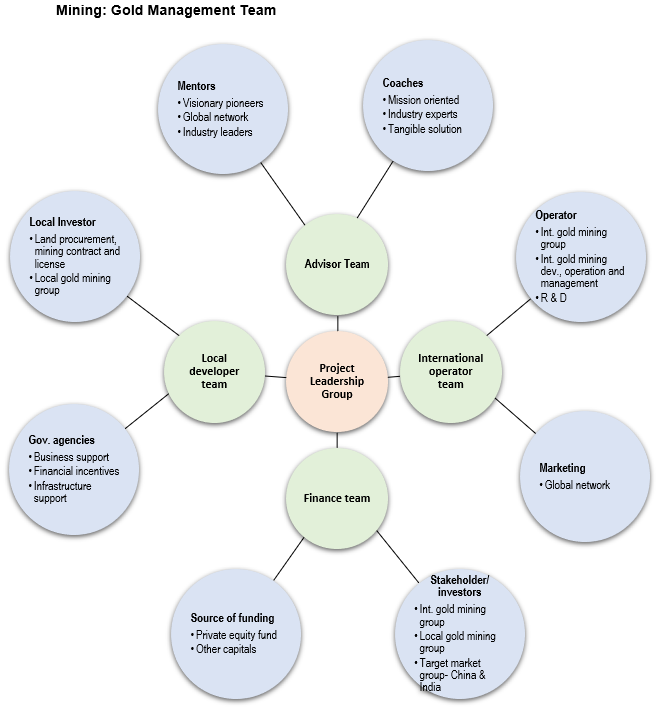
8.0 Unique Business Model
8.1 Successful Track Record
- The team consists of international and local gold mine developers, operators, fund managers, investors, supportive government agencies, and mine specialists.
8.2 Entry Model
- Entry options include Greenfields and Brownfields investments.
- A Hybrid model allows foreign investors to buy into existing coal-mining groups, capture existing mining rights, expand exploration, and secure long-term returns.
- Production methods involve purchasing or leasing new equipment or outsourcing operations to mining operators.
8.3 Key Features of the Unique Business Model
- A top-notch international gold mining team with a proven track record.
- Partners with complementary strengths working towards common goals.
- Solid financial backing.
- Strategic partnerships with target customers in India and China.
- Convenient access to target markets.
9.0 Key Success Factors & Risk Mitigation
9.1 Key Success Factors
- Maintaining a low-cost position with efficient processing.
- Leveraging technology to boost productivity.
- Ensuring secure demand through strategic partnerships with end buyers.
- Benefiting from supportive infrastructure, tax incentives, and government backing.
- Accessing high-grade mineral ores for sustainable financial returns.
- Building a capable team with strong financial and operational expertise.
- Securing a long mine life.
9.2 Risks
- High Costs: The substantial investment in time, finances, and expertise required for gold mine exploration.
- Failure Rate: The extremely low likelihood of success, as only a fraction of prospected sites lead to productive mines, with a mere 10% of global gold deposits justifying further development.
- Price Volatility: Fluctuations in gold prices impacting production timing.
- Licensing Changes: Policy and mining law alterations affecting business and licenses.
- Financial Risks: Rising labour and material costs affecting financial viability.
9.3 Risk Mitigation
- Trust: Establishing high-quality partnerships to enhance overall success.
- Support: Leveraging government support, fiscal incentives, and streamlined permit approvals.
- Technology: Engaging foreign gold mining specialists to ensure technological competence, leading to increased productivity and lower costs.
- Demand: Involving end buyers in the investment to mitigate the impact of volatile price fluctuations.
- Local Engagement: Collaborating with local mining groups to gain community support and address potential challenges.
10.0 Exit Strategy
10.1 Forms of Exit
- Potential exit strategies include Initial Public Offering (IPO), buy-outs, mergers and acquisitions (M&A), and project transfers.
10.2 Key Attractions for New Investors
- Portfolio Diversification: Gold mine projects offer an opportunity for alternate investments in an emerging market.
- Secure Demand: Strategic partnerships with end buyers ensure a steady demand for gold.
- High Barriers to Entry: The high cost of investment creates significant barriers to entry for competitors.
- Cost Efficiency: The consolidation of costs through the acquisition of new gold mine projects.
- Growth Potential: Opportunities for capturing growth in an emerging market.
- ESG Commitment: A commitment to responsible corporate Environmental, Social, and Governance (ESG) practices aligned with purpose-driven investment.